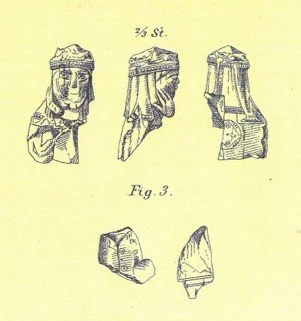THE ORIGIN OF
LEWIS CHESS LEGENDS
Lewis Chess Legends will be an annual international chess festival in Trondheim, Norway, which is founded in a unique history and carried out in unique surroundings. Our vision “We think big and pursue the exceptional”.
THE
DISCOVERY
&HISTORY
The Lewis chess pieces were discovered on the Isle of Lewis in the Outer Hebrides of Scotland in 1831. However, it's uncertain where they are from or how they got to the island. The leading theory suggests that they were made in Trondheim, located in the heart of Norway around 1150–1200. There are several reasons for this. Firstly, Trondheim was a center for walrus ivory carving in the Middle Ages. Secondly, a fragment of a queen piece in a similar style was found in a local church. Finally, the faces and decorations on the chess pieces resemble carvings found in the Nidaros Cathedral.
The Archbishop introduced a tax system throughout the diocese, and every year Greenland had to pay taxes to the Archbishop of Nidaros. The archives in Nidaros document shipments of up to 150 walrus teeth in tax per year.
A good portion was used to make both decorative and functional items such as religious objects, jewelry and probably - chess pieces!
In 1831, 78 chess pieces made of walrus teeth were found on the island of Lewis in the Hebrides, and are considered the world's oldest remaining complete set of chess pieces. Much research suggests that the chess pieces were made by the craftsmen who had been hired to decorate Nidaros Cathedral.
Since they were found, the Lewis’ pieces have been on display at the British Museum in London, and as the world's oldest is one of the few objects the museum highlights in its marketing. Some of the pieces are exhibited at the National Museum of Scotland.
The fact that the world's oldest remaining complete set of chess pieces was made in the Archbishop's Palace, and an international chess tournament, can both shine a spotlight on a fantastic history and at the same time give the Archbishop's Palace relevance.
-

The Queen
Discovered in 1885 in Olavskirken in Trondheim. Identical queen from the Lewis-pieces.
-

Identical face design
Sculpture from Nidaros Cathedral around 1150-60.
-

The King
Chess King found in Hitra in Trøndelag, Norway.
THe LEWIS CHESSMEN
- FUN FACTS -
Who owned the Lewis-pieces?
From 7th-century India, chess passed to the Middle East and then to Europe . The Lewis Chesspieces might have belonged to a trader who was travelling from Norway to Ireland to sell them, who stopped at Lewis on route.
Another theory is that they were intended for local nobility on the island. However, no one can be sure when or why they were deposited. Various stories – involving everything from a grazing cow revealing the hoard to a sailor, to even murder – have evolved to explain why they were buried and how they were discovered. All that's certain is that they were found some time before 11 April 1831, when they were exhibited in Edinburgh at the Society of Antiquaries of Scotland.
They're made of walrus ivory and sperm whale tooth
Walrus ivory was widely used in northern Europe for luxury carvings – the narrow tusk was suitable for making gaming pieces. The tusks used for the Lewis Chessmen may have come from Greenland, which had a good trading relationship with Norway in the Middle Ages.
The Lewis Chesspieces are some of the most well-travelled objects in the British Museum-collection
Since 1995, various pieces have been shown in over 20 exhibitions around the world. Their characterful expressions are instantly appealing, from the queens' worried manner to warriors biting their shields! In 2025 they will come to Trondheim!
Hollywood famous!
In 2001 the first Harry Potter film, Harry Potter and the Philosopher's Stone, used a replica of the Lewis chess set – owned by British Museum curator Irving Finkel – that Ron and Harry have to overcome near the film's climax.
They've taken on a life of their own
Today the Lewis Chessmen have been replicated and reimagined in many different ways. They've also appeared in the manga graphic novel Professor Munakata's British Museum Adventure and as a giant Lego sculpture made up of over 90,000 bricks, created at the National Museum of Scotland. And new 3D scans of some of the chessmen let visitors move the pieces around and enjoy them in a whole new way.
OUR GOALS
1. Spread knowledge and commitment about the Lewis Chess-pieces' and its connection to the Nidaros Cathedral and the Archbishop's Palace.
2. Develop a unique international chess festival of high quality based on the unique history.
3. To promote equality between genders.
4. Award the world's best female chess player.
Mission &
Commitment
The history of Nidaros Cathedral and the Archbishop’s diocese must be made available and communicated to the public.
The communication must create reflection and understanding, use modern methods and be adapted to different target groups.
Nidaros Domkirkes Restaureringsarbeider (NDR) will ensure annual implementation by using all facilities in the Archbishop's Palace and providing its own human resources within event execution and marketing expertise. This is to ensure good conditions for next year's tournament.
NDR have made an agreement with Hell Chess Club as tournament organizer.



